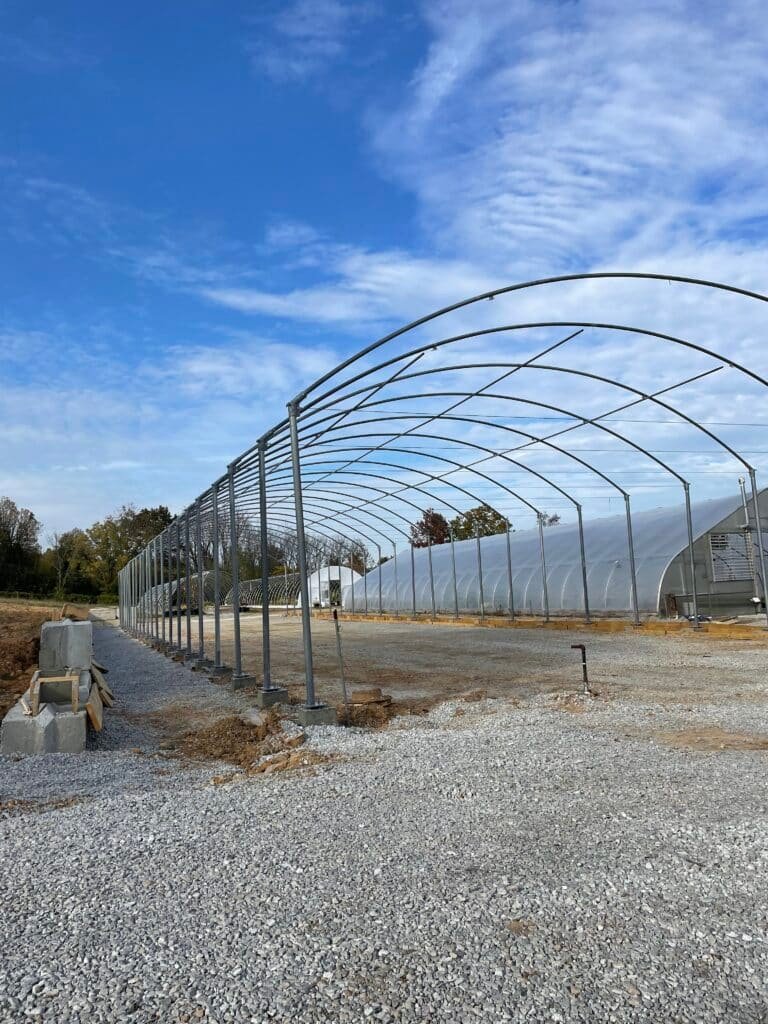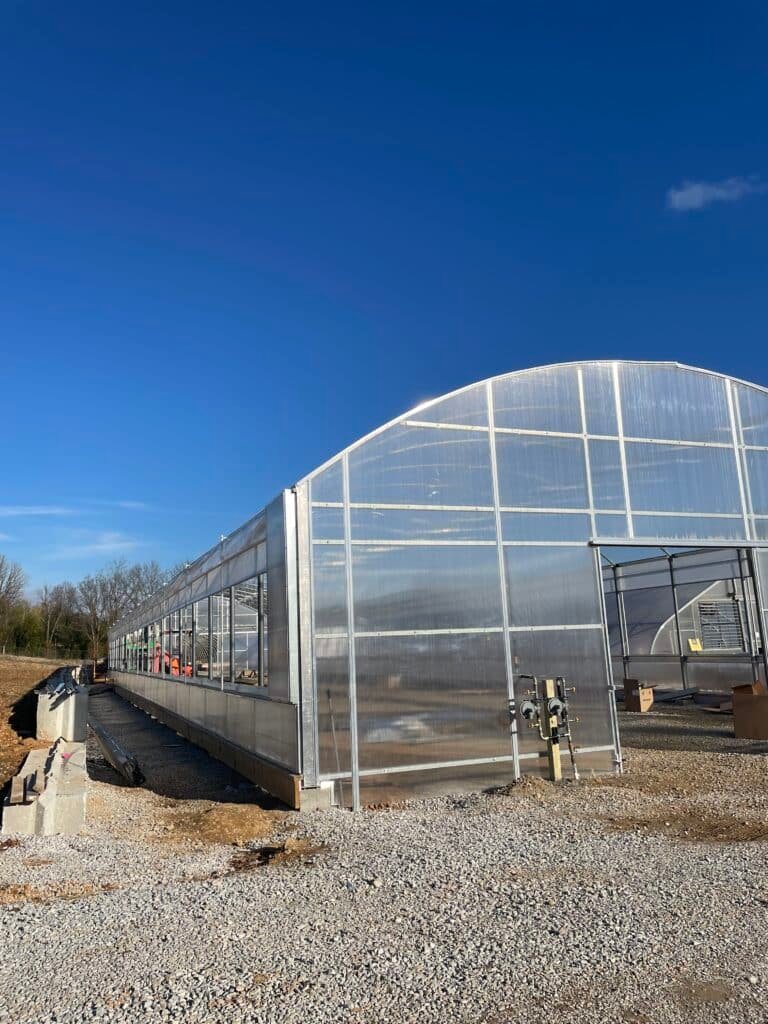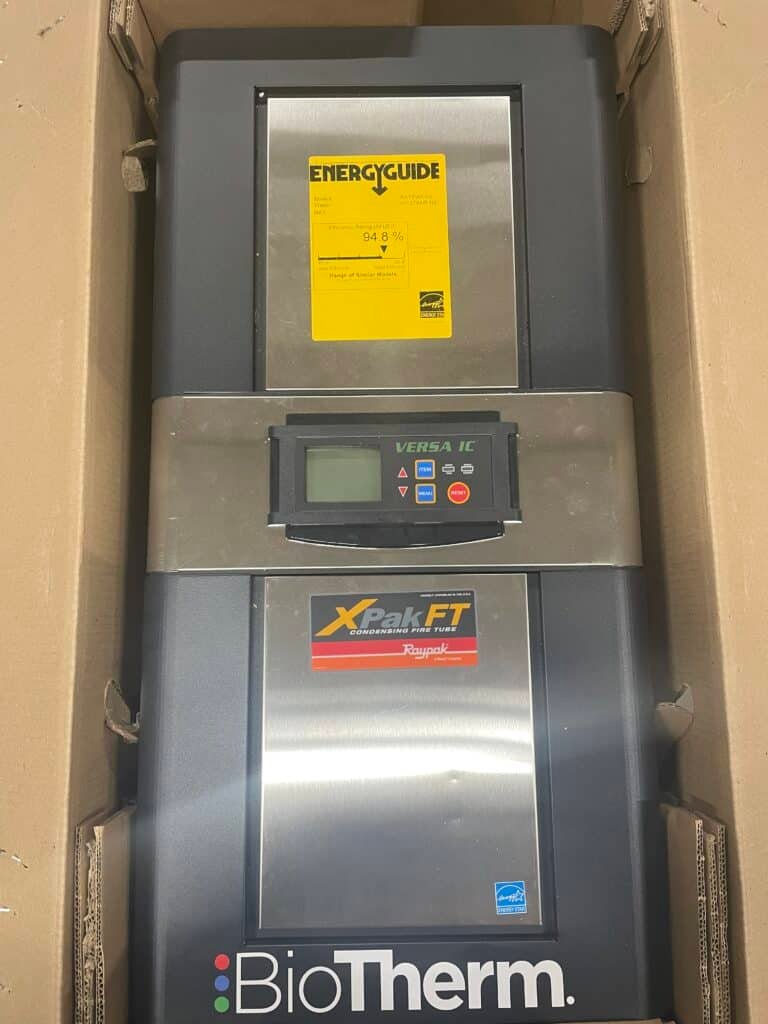Features of the newest Yew Dell greenhouse
It’s cold, blistery days like this that seem like a perfect time to talk about greenhouses. After all, we’re putting the final touches on the new greenhouse we’re adding to our nursery.
But what has made this greenhouse so special to Jeff, Cosmo, and the rest of the Yew Dell Staff? Greenhouses come in all sorts of designs, with many different environmental controls available and serve a long list of growing needs. We have had several different types at Yew Dell and have been working on adding this new weapon to our arsenal of abilities to grow awesome plants.
Two things had happened to bring this about. One, the small greenhouse we were using to grow shade perennials and maintain a minimum winter temperature just above freezing was falling down and not big enough. Second, our heated greenhouse used for annuals in the spring was getting pretty cramped for space.
We made the decision to transform our heated house for annuals into the one for shade perennials and construct a new greenhouse for annuals. Here is why and how that went into the design process.
The frame itself
It isn’t small. From side to side, it is 32’ wide and stretches an impressive 132’ long. Unlike many greenhouses you see with the arch coming all the way to the ground, this one has straight up and down sidewalls that are 10’ tall. The arch on this greenhouse only goes from one side of these sidewalls to the other.
Cooling
We learn at an early age what happens when the sun shines on a greenhouse. The warm sunlight goes in but is trapped inside the house and the temperature increases very fast to very high temperatures. I have been in greenhouses shutdown in the summer and the temperatures are pushing 150 degrees Fahrenheit! In many ways, it is easier to keep a greenhouse heated in the winter than it is to keep one cool in the summer. We spent a lot of time thinking about this and visited a nursery in Ohio while planning how to cool this new greenhouse. All the cooling is passive in this house! That means there are no exhaust fans that blow the hot air out of the house. Much like our glasshouse at Yew Dell, this new house has a ridge vent on the top of it that runs the entire length. As the temperatures reach a set point, this vent will automatically crack open, allowing heat to escape from the top. As the temperature continues to rise, the vent will open a little more, and if not enough to cool the greenhouse, it will then open all the way up.
That is plenty of cooling for the sunny days in February and March but as we get into the warmer days of spring the ridge vent alone will not be enough. This is where those 10’ tall sidewalls come in. The bottom 2.5’ are a solid wall covered with a clear polycarbonate. The remaining 7.5’ feet is a roll up curtain. These curtains are made of what could be described as a clear, woven tarp-like material. When the ridge vent is open all the way and the temperatures are still too high, the curtains will automatically open to 1 of 3 heights, depending on temperatures. Having the ability to open these sidewalls will allow us to utilize this greenhouse even in the hottest parts of the summer!
Heating
I mentioned that it is easier to heat a greenhouse than it is to cool one but there is a big difference in how efficient the heating sources are. Keeping this in mind and again, taking some elements from our glasshouse design, we opted to go with a heated floor system. We all know that heat rises and when you start with floor heat, the plants on the ground get the heat and not the air above them. The system for this house is broken up into 3 zones. This will allow us to keep different areas at different temperatures. The benefit of this is simply being able to keep heat loving plants together and those that do fine in cooler temps together. There are not many plants more unhappy than things like peppers, lantana, and Persian shield in a cool, drafty greenhouse in March. We can now easily work around that. The boiler system burns natural gas but it is the efficiency that is the impressive part. It is around 95% efficient! The percentage of efficiency of forced air heaters that blow out hot air are in the low 80s. We will only be using this type of heater in this house to supplement heating needs if it is very cold out or to melt snow off the top of the greenhouse.
We are incredibly excited to get this house finished and move in this March and produce the annuals for the gardens, the starts for our first Heirloom Tomato Sale, and what will be the plants used to grow the flowers in our expanding cut flower garden. It has been about five years since we really started building out the nursery at Yew Dell and this new greenhouse will be the cherry on top. We have designed and built many different types of structures to allow us to grow an endless amount of plants for Sayde in the gardens, Brad in the woodlands, and Jill in the cut flower garden. Just as a seed germinates and grows into a plant, the nursery at Yew Dell started off as an idea to help the gardens and has since grown into a true plant producing machine!





